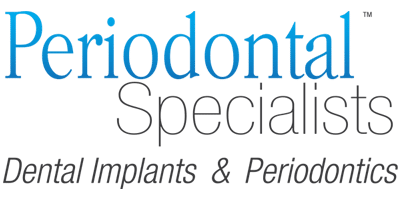several treatment solutions available to correct esthetic concerns
Periodontal therapy offers several treatment solutions and options to correct esthetic concerns associated with natural teeth and dental implants. Drs. Robinson and Barget have mastered the appropriate diagnosis and surgical skills to correct these issues and enhance your smile and esthetic results.
These procedures are used to treat gum recessions and the anatomic deformities (exposed root surfaces), which may compromise the structural integrity of teeth or negatively impact cosmetics.

Esthetic Gum Grafting
The gingiva is the gum area around the root of the tooth. When major recession of this gum area occurs, the body loses a natural defense against both bacteria and trauma. Gum recession often results in root sensitivity to hot and cold foods as well as an unsightly appearance to the gum and tooth.
Significant gum recession can expose the root surface, which is softer than tooth enamel, leading to root caries and root gouging. A gingival graft periodontal therapy is designed to solve these problems. A thin piece of tissue is taken from the roof of the mouth (palate), or gently moved over from adjacent areas, to provide a stable band of attached gingiva around the tooth.
The gingival graft may be placed in such a way as to cover the exposed portion of the root. In certain cases, we can avoid using the palate as a donor site by using a bioactive gel (Gem-21, Emdogain) in conjunction with a bone graft material and a bioabsorbable membrane to achieve the same goal of root coverage.

Esthetic Crown Lengthening
An esthetic smile is a result of properly aligned teeth that are fully exposed. Excess gum tissue that covers the anatomic tooth structure results in teeth that appear too short or a smile that displays excessive gum tissue (gummy smile).
Esthetic crown lengthening is a minimally invasive surgical periodontal therapy procedure to expose proper tooth length, proportions, and the appearance of your natural teeth. This procedure can be performed on natural teeth with no restoration to follow or teeth that are going to be restored by your restorative dentist.
Ridge Augmentation
There is a type of graft procedure which is used to correct deformities in the jaw bone that have resulted from loss of teeth. When teeth are lost the remaining bone (residual ridge) may be injured or become atrophic and lose height or volume. This may result in cosmetic and or functional deformities.
The bone volume may be too small to hold dental implants or loss of gum height under bridges may negatively affect the smile. These ridge deficiencies can be corrected using bone or soft tissue graft techniques. Ridge augmentation is a safe, predictable surgical enhancement.
When the traditional method of placing an implant is used, the shortest time frame for a complete implant is about five months in the lower jaw and six months in the upper jaw. This includes surgeries and placing the permanent crown. However, the process can last a year or more, particularly if bone needs to be built up first. In another technique, implants and healing caps are placed at the same time as well as the crown, bridge or denture at the same visit.

